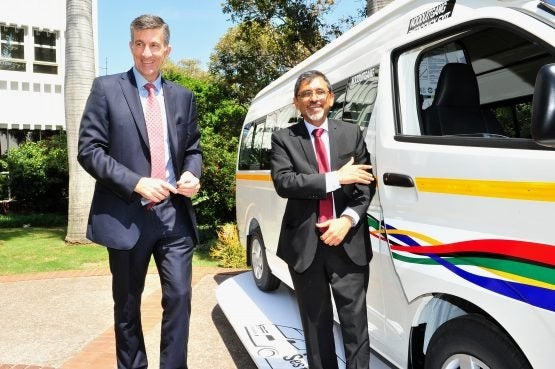
Toyota South Africa Motors (TSAM) has announced that it has boosted its investment in its HiAce Ses’fikile taxi vehicle plant in Prospecton near Durban to more than R1 billion since 2012. Its latest R454 million investment will enhance local production of the model by increasing the local value addition.
The manufacturer has also invested almost R20 million in a packing plant to support the commencement later this month of its export operations and local assembly of its Hilux model in Kenya.
Andrew Kirby, president and chief executive of TSAM, says the enhancements to local production of the HiAce Ses’fikile model have created an additional 80 jobs in the plant while 20 additional people have been employed because of the investment in the packing operation.
Localisation boost for the economy
Kirby says TSAM is committed to supporting the South African Automotive Masterplan and has proactively increased the local value addition of the HiAce Ses’fikile to 44% from 38%, with this localisation adding R422 million a year in local value addition to the economy.
The automotive industry and government agreed on the masterplan last year. In terms of the plan, it is envisaged that employment in the automotive manufacturing industry will double to about 240 000 by 2035, with vehicle production increasing from 600 000 to almost 1.4 million units that year, and local content rising from 39% to 60%.
Kirby says the latest investment by TSAM in the HiAce plant followed its initial investment in 2012, adding that it switched from importing the HiAce as a completely built-up unit (CBU) to a semi knocked-down (SKD) vehicle at that point, and to a completely knocked-down (CKD) model in 2015.
“Since the introduction of the local manufacture of this product, we have seen volumes increase from 9 300 to 14 000 units per year, which equates to an increase of 37%.”
He adds: “The most recent increase in demand from our customers to 15 000 units per annum has given us this opportunity to deepen our localisation, which will allow us to improve affordability over time.
“The minibus taxi industry plays a pivotal role within the South African transport system, and as such, is important in supporting the wheels of our economy.”
In terms of market share, TSAM has about 80% of the taxi vehicle market, with the taxi industry transporting more than 15 million or about 70% of the commuting public daily.
Ebrahim Patel, Minister of Trade, Industry and Competition, says the latest investment by TSAM is another major vote of confidence in the capability of the South African automotive industry and the KwaZulu-Natal economy.
Patel says manufacturing is the largest contributor to economic output in the province and supports more than 350 000 direct jobs, noting that more than 80 000 taxis have been assembled locally by Toyota since TSAM’s localisation programme commenced.
“The increased level of local content is an important part of the 2035 vision for the industry and will increase the participation of more South Africans in this thriving sector of the economy.”
The investment in the Hilux packing plant follows Kirby’s announcement in February this year that TSAM is expanding its footprint in Africa and considering exporting knocked-down kits for assembly in some countries on the continent.
Kirby said at the time that TSAM had identified a number of core countries in Africa that made sense for this project – including the East Africa bloc with Kenya as its centre, and the West African bloc, which includes the Nigeria-Ghana region – and that a final decision had not yet been made on the countries to which TSAM would export the kits, which would predominantly be Hilux models.
He announced on Friday that production in Kenya will commence later this month, with benefits for customers in the Kenyan market in that they will be able to buy their vehicles at a more competitive price.
He says TSAM is committed to the growth of the automotive industry and, as such, will continue its contribution to the social and economic development of Africa as a whole.



